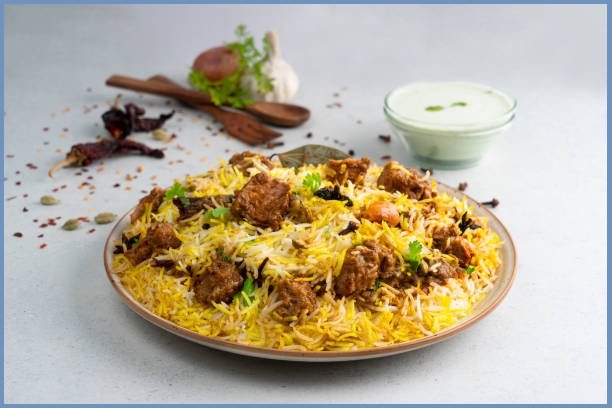
How to Make Hyderabadi Mutton Biryani Introduction
Mutton Biryani, a regal dish with a rich history, has won hearts worldwide with its aromatic spices and tender meat. This guide aims to provide a detailed, chapter-wise explanation to help you master this exquisite dish. Whether you are a novice or an experienced cook, following these steps will ensure a flavorful and perfectly cooked Mutton Biryani.
Chapter 1: Gathering Ingredients
The first step to making a perfect Mutton Biryani is gathering fresh, high-quality ingredients. Here’s what you’ll need:
Mutton: 1 kg, preferably from the shoulder or leg, cut into medium-sized pieces.
Basmati Rice: 500 grams, long-grain.
Onions: 3 large, thinly sliced.
Tomatoes: 2 large, chopped.
Yogurt: 1 cup.
Garlic Paste: 2 tablespoons.
Ginger Paste: 2 tablespoons.
Green Chilies: 4-5, slit.
Fresh Coriander and Mint Leaves: A handful each, chopped.
Lemon Juice: 2 tablespoons.
Ghee: 3 tablespoons.
Oil: 4 tablespoons.
Saffron: A pinch, soaked in warm milk.
Whole Spices: 4-5 cardamom pods, 4-5 cloves, 2-3 cinnamon sticks, 2 bay leaves, and 1 star anise.
Spice Powders: 2 tablespoons biryani masala, 1 teaspoon turmeric, 1 teaspoon red chili powder, 1 teaspoon cumin powder, and salt to taste.
Chapter 2: Marinating the Mutton
Marinating the mutton is crucial for tender, flavorful meat. Follow these steps:
In a large bowl, mix the mutton pieces with yogurt, garlic paste, ginger paste, turmeric, red chili powder, biryani masala, and salt.
Add half of the chopped coriander and mint leaves, and half of the slit green chilies.
Rub the spices thoroughly into the meat, ensuring every piece is evenly coated. Cover the bowl tightly with plastic wrap and refrigerate for a minimum of 4 hours, preferably overnight.
Chapter 3: Preparing the Rice
While the mutton marinates, prepare the rice:
Rinse the basmati rice under cold water until the water runs clean. This removes excess starch.
Allow the rice to soak in water for 30 minutes, then drain thoroughly.
In a large pot, bring water to a boil and add salt, 1 tablespoon of oil, and whole spices (cardamom, cloves, cinnamon, bay leaves, and star anise).
Add the soaked rice and cook until it’s 70% done (the grains should still have a bite to them).
Drain the rice and spread it on a large plate to cool.
Chapter 4: Frying the Onions
Caramelized onions add depth and sweetness to Biryani. Here’s how to make them:
Heat oil and ghee in a large, heavy-bottomed pan.
Add the thinly sliced onions and fry them over medium heat, stirring frequently.
Cook until the onions are golden brown and crispy, then drain on paper towels.
Chapter 5: Cooking the Mutton
Next, cook the marinated mutton:
In the same pan used for frying onions, add the marinated mutton and cook over medium-high heat.
Add chopped tomatoes and cook until they soften and blend with the meat.
Lower the heat and cover the pan, allowing the mutton to cook in its juices for about 45 minutes or until tender.
If necessary, add a little water to prevent sticking, but ensure the mixture remains thick.

Chapter 6: Layering the Biryani
Layering is a critical step in achieving the perfect Biryani. Follow these instructions:
In a large, heavy-bottomed pot, spread a layer of the cooked mutton at the bottom.
Add a layer of parboiled rice over the mutton.
Sprinkle some fried onions, chopped coriander and mint leaves, and slit green chilies.
Repeat the layers until all the rice and mutton are used, finishing with a layer of rice.
Drizzle the saffron milk and lemon juice over the top layer.
Cover the pot with a tight-fitting lid or seal with aluminum foil.
Chapter 7: Dum Cooking
“Dum” refers to slow cooking, which melds the flavors beautifully:
Place the sealed pot on a heat diffuser or a tawa (griddle) over low heat.
Cook for 30-40 minutes, allowing the steam to cook the rice and meat together.
Alternatively, you can place the pot in a preheated oven at 150°C (300°F) for the same duration.
Chapter 8: Serving the Biryani
Presentation matters as much as taste. Serve your Biryani with these accompaniments:
Raita: A cooling yogurt-based side with chopped cucumber, onions, and tomatoes.
Salad: Fresh greens with lemon wedges.
Papad: Crispy, spiced wafers.
Conclusion
Mastering Mutton Biryani may seem daunting, but with this detailed, chapter-wise guide, you can create a dish that impresses everyone. The key lies in the quality of ingredients, proper marination, and slow cooking to bring out the rich, complex flavors. Enjoy the process, and savor every bite of your homemade Mutton Biryani!
Tips for Perfection:
Use Fresh Spices: Freshly ground spices elevate the flavor profile of your Biryani.
Patience is Key: Allowing the mutton to marinate and cook slowly ensures tenderness and richness.
Balance the Heat: Adjust the number of green chilies and chili powder to suit your spice preference.
Final Thoughts
Creating the perfect Mutton Biryani is an art that combines patience, precision, and passion. By following this comprehensive guide, you can delight your family and friends with a dish that is not only delicious but also a true labor of love. Enjoy the rich aromas and the burst of flavors in every mouthful, and remember, the journey to mastering Biryani is as rewarding as the dish itself.
Introduction to Hyderabadi Biryani: Briefly introduce Hyderabadi Biryani, mentioning its origin in the royal kitchens of Hyderabad, India. Highlight its popularity and unique features compared to other biryanis.
Ingredients: List and describe the essential ingredients for Hyderabadi Mutton Biryani. Include specific details such as the type of rice (preferably long-grain basmati), cuts of mutton (typically from the shoulder or leg), and key spices like saffron, cardamom, cloves, cinnamon, and bay leaves.
Preparation Steps: Provide a step-by-step guide on how to prepare Hyderabadi Mutton Biryani, focusing on the traditional method involving marination, layering, and dum cooking (slow cooking).
Marination: Explain the importance of marinating the mutton with yogurt, spices, and herbs to enhance flavor and tenderize the meat.
Rice Preparation: Detail the process of parboiling the rice with whole spices and preparing it for layering.
Layering: Describe the technique of layering cooked mutton and rice in a heavy-bottomed pot, interspersed with fried onions, mint, and coriander leaves.
Dum Cooking: Highlight the dum cooking method, where the biryani is sealed and cooked on low heat, allowing the flavors to meld together.
Tips for Perfection: Include practical tips to ensure the best results, such as using fresh ingredients, adjusting spice levels according to preference, and maintaining patience during the cooking process.
Accompaniments: Suggest traditional accompaniments like raita (yogurt sauce with cucumbers and spices), salad, and papad (crispy wafers) to complement the flavors of Hyderabadi Biryani.
History and Cultural Significance: Provide a brief insight into the cultural significance of Hyderabadi Biryani, its historical background, and its place in Indian culinary traditions.
Conclusion: Summarize the key points and encourage readers to try making Hyderabadi Mutton Biryani at home, emphasizing its rich flavors and the rewarding experience of mastering this iconic dish.










